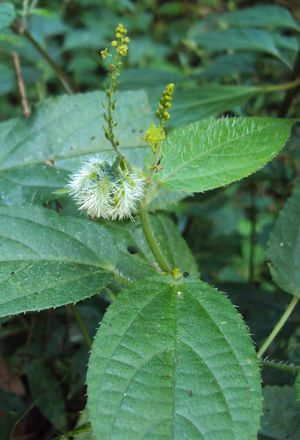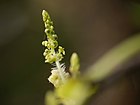Note: This is a project under development. The articles on this wiki are just being initiated and broadly incomplete. You can Help creating new pages.
Difference between revisions of "Tragia involucrata - Duhsparsha"
(→External Links) |
(→List of Ayurvedic medicine in which the herb is used) |
||
| Line 47: | Line 47: | ||
==List of Ayurvedic medicine in which the herb is used== | ==List of Ayurvedic medicine in which the herb is used== | ||
| − | |||
==Where to get the saplings== | ==Where to get the saplings== | ||
Revision as of 17:11, 13 June 2019
Tragia involucrata is a perennial twinning herb, covered with stinging hairs. Flowers are borne in racemes in leaf axils. Female flowers are few, in lower part of inflorescence; male flowers are many in the upper part. Fruit is a 3-lobed capsule, containing 3 round smooth seeds.
Contents
- 1 Uses
- 2 Parts Used
- 3 Chemical Composition
- 4 Common names
- 5 Properties
- 6 Habit
- 7 Identification
- 8 List of Ayurvedic medicine in which the herb is used
- 9 Where to get the saplings
- 10 Mode of Propagation
- 11 How to plant/cultivate
- 12 Commonly seen growing in areas
- 13 Photo Gallery
- 14 References
- 15 External Links
Uses
Fever, Itching, Bronchits, Skin Diseases, Baldness.
Parts Used
Chemical Composition
Seeds yield a fixed oil containing about 62% linoleic acid and enzymes. They are also rich in proteins (Ghani, 2003)[1]
Common names
| Language | Common name |
|---|---|
| Kannada | Turike Balli |
| Hindi | Barhanta |
| Malayalam | Kodithoova, Cherukodithuva |
| Tamil | Kanchori |
| Telugu | Telukondicettu |
| Marathi | NA |
| Gujarathi | NA |
| Punjabi | NA |
| Kashmiri | NA |
| Sanskrit | Vrischikali |
| English | stinging nettle |
Properties
Reference: Dravya - Substance, Rasa - Taste, Guna - Qualities, Veerya - Potency, Vipaka - Post-digesion effect, Karma - Pharmacological activity, Prabhava - Therepeutics.
Dravya
Rasa
Guna
Veerya
Vipaka
Karma
Prabhava
Habit
Identification
Leaf
| Kind | Shape | Feature |
|---|---|---|
| Simple | Leaves 6-10 x 3-5.5 cm | Ovate or elliptic, base acute or rounded, margin serrate, apex acuminate, hispidulous on both sides and petiole to 2.5 cm long |
Flower
| Type | Size | Color and composition | Stamen | More information |
|---|---|---|---|---|
| Unisexual | 2 cm long | Yellow | 3-5 | Female flowers c. 3 mm across, ebracteate; tepals 6, c. 1 mm long, ovate-lanceolate, enlarged and spreading in fruits |
Fruit
| Type | Size | Mass | Appearance | Seeds | More information |
|---|---|---|---|---|---|
| enlarged | ovate-lanceolate | Capsule c. 0.6 x 1 cm, 3-lobed, hispid | With hooked hairs | Seeds globose | {{{6}}} |
Other features
List of Ayurvedic medicine in which the herb is used
Where to get the saplings
Mode of Propagation
How to plant/cultivate
Easily grown in most soils, preferring a calcareous soil. Thrives in a dry lightly shaded position[16], though it prefers full sun. Plants usually self-sow quite freely when growing in a suitable position[19]. The seeds are contained in burrs that can easily attach themselves to clothing or animal's fur, thus transporting them to a new area where they can germinate and grow.The cultivar 'Sweet scented' is popular in France for making tea because the whole plant is sweet scented and the flowers have a spicy apricot-like fragrance[3]
Commonly seen growing in areas
Tall grasslands, meadows, Borders of forests and fields.
Photo Gallery
References
External Links
- Ayurvedic Herbs known to be helpful to treat Fever
- Ayurvedic Herbs known to be helpful to treat Itching
- Ayurvedic Herbs known to be helpful to treat Bronchits
- Ayurvedic Herbs known to be helpful to treat Skin Diseases
- Ayurvedic Herbs known to be helpful to treat Baldness
- Herbs with Leaves used in medicine
- Herbs with Roots used in medicine
- Herbs with common name in Kannada
- Herbs with common name in Hindi
- Herbs with common name in Malayalam
- Herbs with common name in Tamil
- Herbs with common name in Telugu
- Herbs with common name in Sanskrit
- Herbs with common name in English
- Habit - Annual herb
- Index of Plants which can be propagated by Seeds
- Herbs that are commonly seen in the region of Tall grasslands
- Herbs that are commonly seen in the region of meadows
- Herbs that are commonly seen in the region of Borders of forests and fields
- Herbs
- Euphorbiaceae








